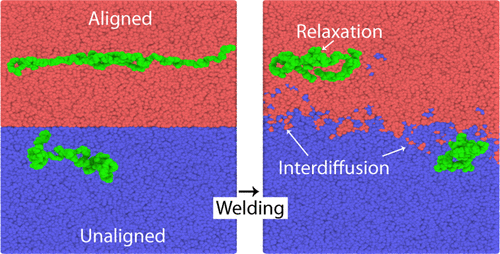当前位置:
X-MOL 学术
›
Macromolecules
›
论文详情
Our official English website, www.x-mol.net, welcomes your feedback! (Note: you will need to create a separate account there.)
Effect of Flow-Induced Molecular Alignment on Welding and Strength of Polymer Interfaces
Macromolecules ( IF 5.5 ) Pub Date : 2020-09-16 , DOI: 10.1021/acs.macromol.0c01508 Marco A. G. Cunha 1 , Mark O. Robbins 1
Macromolecules ( IF 5.5 ) Pub Date : 2020-09-16 , DOI: 10.1021/acs.macromol.0c01508 Marco A. G. Cunha 1 , Mark O. Robbins 1
Affiliation

|
Structures formed by fused filament fabrication are often substantially weaker than those made with conventional techniques and fail at the welds between successive layers. One factor that may influence strength is flow-induced alignment of the deposited material. A recent work suggests that alignment reduces the entanglement density and thus should accelerate welding by diffusion. Here, coarse-grained molecular simulations are used to test the effect of molecular alignment on diffusion and weld strength. While standard measures show a decrease of the entanglement density with alignment, there is no change in the rate of diffusion normal to the interface or the rate of formation of entanglements across the interface. The time for chain reorientation also remains equal to the equilibrium disentanglement time τd. Despite this, simulations of mechanical tests show that welds formed from aligned states are weaker until several τd. This is not because the weld itself is weaker, but because the aligned material near the weld is weaker than the unaligned material. The maximum shear strength and tensile fracture energy of welded systems are the same as bulk systems with the same alignment.
中文翻译:

流致分子取向对聚合物界面焊接和强度的影响
通过熔融长丝制造形成的结构通常比传统技术制造的结构弱得多,并且在连续层之间的焊接处失效。可能影响强度的一个因素是沉积材料的流致对准。最近的一项工作表明,对准降低了缠结密度,因此应通过扩散来加速焊接。在这里,使用粗粒度分子模拟来测试分子排列对扩散和焊接强度的影响。尽管标准措施显示缠结密度随着对准而降低,但垂直于界面的扩散速率或整个界面上的缠结形成速率均没有变化。对于链重新定向的时间也保持等于平衡解缠结时间τ d。尽管这样,机械测试模拟表明,从对齐的状态形成的焊缝弱直到几个τ d。这不是因为焊缝本身较弱,而是因为焊缝附近的对齐材料比未对齐的材料弱。焊接系统的最大剪切强度和拉伸断裂能与具有相同排列的整体系统相同。
更新日期:2020-10-13
中文翻译:

流致分子取向对聚合物界面焊接和强度的影响
通过熔融长丝制造形成的结构通常比传统技术制造的结构弱得多,并且在连续层之间的焊接处失效。可能影响强度的一个因素是沉积材料的流致对准。最近的一项工作表明,对准降低了缠结密度,因此应通过扩散来加速焊接。在这里,使用粗粒度分子模拟来测试分子排列对扩散和焊接强度的影响。尽管标准措施显示缠结密度随着对准而降低,但垂直于界面的扩散速率或整个界面上的缠结形成速率均没有变化。对于链重新定向的时间也保持等于平衡解缠结时间τ d。尽管这样,机械测试模拟表明,从对齐的状态形成的焊缝弱直到几个τ d。这不是因为焊缝本身较弱,而是因为焊缝附近的对齐材料比未对齐的材料弱。焊接系统的最大剪切强度和拉伸断裂能与具有相同排列的整体系统相同。



























 京公网安备 11010802027423号
京公网安备 11010802027423号